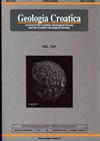Modification of slope stability probability classification and its application to rock slopes in hydropower engineering regions
IF 1.1
4区 地球科学
Q3 GEOLOGY
引用次数: 3
Abstract
Stability assessment of rock slopes in hydropower engineering regions is an important and complex issue. Rock mass classification systems are a good approach because they can thoroughly consider many factors influencing rock slope stability. The slope stability probability classification (SSPC) system is a novel method. However, it has two limitations when applied to rock slopes: 1) it is only suitable for slopes less than 45 m in height, and 2) there is great subjectivity and randomness in the estimation of intact rock strength. Therefore, this study presents two modifications of the SSPC system by adopting the Hoek-Brown strength criterion and an empirical formula for maximum slope height. Evaluation of results from of 34 typical rock slopes of the major hydropower engineering regions in China indicated that the accuracy rate of the modified SSPC for stability evaluation of these slopes was 61.8%, and the accuracy for stability evaluation of 10 slopes with non-structural control failure was 80%. The stability values of stable and unstable slopes obtained using the modified SSPC were different to those obtained using the Chinese Slope Mass Rating (CSMR) and modified CSMR systems. In addition, the identification accuracy rate of the modified SSPC was significantly higher than that of the CSMR and modified CSMR. Therefore, the modified SSPC can be applied to hydropower engineering regions, providing a new means of rapidly evaluating the slope stability of high rock slopes (slopes > 45 m in height) in these regions.水电工程区边坡稳定概率分类的修正及其在岩质边坡中的应用
水电工程区岩质边坡稳定性评价是一个重要而复杂的问题。岩体分类系统是一种很好的方法,因为它能全面考虑影响岩质边坡稳定性的诸多因素。边坡稳定概率分类(SSPC)系统是一种新颖的方法。但是,它在应用于岩质边坡时存在两个局限性:1)只适用于高度小于45 m的边坡;2)完整岩石强度估计存在较大的主观性和随机性。因此,本研究采用Hoek-Brown强度准则和最大坡高经验公式对SSPC体系进行了两种修正。对中国主要水电工程区34个典型岩质边坡的稳定性评价结果表明,改进的SSPC对这些边坡稳定性评价的准确率为61.8%,对10个非结构控制破坏边坡的稳定性评价准确率为80%。采用改进的SSPC系统得到的稳定和不稳定边坡的稳定值与采用中国边坡质量等级(CSMR)和改进的CSMR系统得到的稳定和不稳定边坡的稳定值不同。此外,改良SSPC的识别准确率显著高于改良CSMR和改良CSMR。因此,改进后的SSPC可应用于水电工程区,为快速评价这些地区高岩质边坡(边坡高度bb0 ~ 45m)的稳定性提供了一种新的手段。
本文章由计算机程序翻译,如有差异,请以英文原文为准。
求助全文
约1分钟内获得全文
求助全文
来源期刊

Geologia Croatica
GEOSCIENCES, MULTIDISCIPLINARY-
CiteScore
2.90
自引率
23.10%
发文量
35
审稿时长
>12 weeks
期刊介绍:
Geologia Croatica welcomes original scientific papers dealing with diverse aspects of geology and geological engineering, the history of the Earth, and the physical changes that the Earth has undergone or it is undergoing. The Journal covers a wide spectrum of geology disciplines (palaeontology, stratigraphy, mineralogy, sedimentology, petrology, geochemistry, structural geology, karstology, hydrogeology and engineering geology) including pedogenesis, petroleum geology and environmental geology.
Papers especially concerning the Pannonian Basin, Dinarides, the Adriatic/Mediterranean region, as well as notes and reviews interesting to a wider audience (e.g. review papers, book reviews, and notes) are welcome.
 求助内容:
求助内容: 应助结果提醒方式:
应助结果提醒方式:


